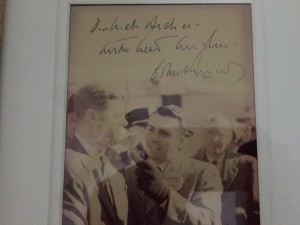 I said this blog would be about journalism, politics, language and life. It all started with this picture. This is my father as a young reporter interviewing John Kennedy on election day 1960 at the Hyannis Airport. I’m told it was the last interview Kennedy did before being elected president.
I said this blog would be about journalism, politics, language and life. It all started with this picture. This is my father as a young reporter interviewing John Kennedy on election day 1960 at the Hyannis Airport. I’m told it was the last interview Kennedy did before being elected president.
A short time after Kennedy was elected, a colleague of my father’s brought it to the White House, and got President Kennedy to sign it. It says, “Nicholas Archer, With best wishes, John F. Kennedy”. It sat on a desk in our home. I was nine years old, and old enough to understand that this was something special. Not every kid had an autographed picture of his father interviewing the president.
I always thought my father’s job was interesting and exciting. We used to see him on the network newscast occasionally before he got into news management. As I grew up through the 1960’s, I was more tuned into what was going on in the world then most of my friends. The Cuban missile crisis, the Kennedy assassination, when my father didn’t come home for those four days in November, the space race, the civil rights movement, Martin Luther King, Robert Kennedy, LBJ, Vietnam, Nixon. I felt like I had an insider’s view of it all.
As I grew up, I help start the high school newspaper, worked on the college radio station, got a journalism degree, and went into the television news business. But the art of writing and the use of language in television news and politics throughout history has always been a fascination. I’ve studied the writings and speeches of Lincoln, Teddy Roosevelt, FDR, Churchill, Kennedy, Martin Luther King, Reagan, Obama, and the journalism of Edward R. Murrow and William Shirer.
The art of the simple declarative sentence in story telling and political argument can educate, change minds and has changed history. “With malice toward none, and charity for all.” “We have nothing to fear, but fear itself.” “Ask not what your country can do for you, but what you can do for your country.” “I have a dream.””Mr. Gorbachev, tear down this wall.” “This instrument (television) can teach, it can illuminate; yes, and even it can inspire. But it can do so only to the extent that humans are determined to use it to those ends. Otherwise, it’s nothing but wires and lights in a box.”
Journalists use language to report the news, tell stories, interpret events, put things in context, and try to be fair and honest. Politicians use language to convince voters and colleagues of the merits of their ideas and points of view, and how they can better our lives and society. But, of course, they are often at odds. Journalists ask questions and can use tactics that politicians don’t like, and sometimes they are right. But it’s not always the media’s fault, as we have heard many times from politicians.
We now live in a time when our journalism and political discourse is more partisan and inflamed then is any time since the 1960’s. I think the reasons for this are many, 9/11, the rise of terrorism, Americans dying in unpopular wars, the shock of a recession, people losing jobs, the election of a black president, the fatal confrontations and mistrust between the police and the minority community. It’s all about ideology. I’m right. You’re wrong. We will never agree to that.
How do we compromise and accommodate opposing views, and get things done? Author Harriet Beecher Stowe once said of Lincoln, “Lincoln’s whole nature inclined him to be a harmonizer of conflicting parties rather than a committed combatant on either side.” Where are the harmonizer today?
We are at the beginning of a long political season. Over twenty people are running for president. We will see the importance of language in the exchange of ideas. It’s the duty of the journalist to fairly report and examine those ideas through questions and research. It’s the responsibility of the candidates not only tell us their ideas, but to show us how they will approach and accommodate those who disagree.
They must show us a picture of the world as they see it, and tell us how they will inspire us, just as one picture inspired a nine year old boy.
Leave a Reply